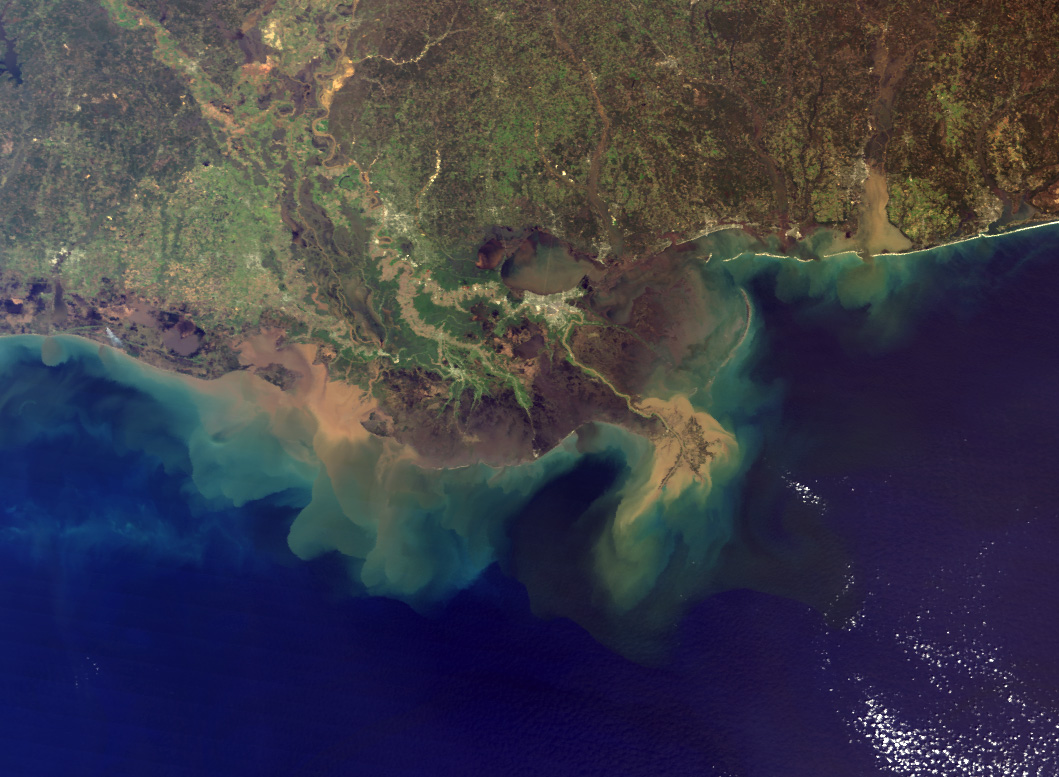Sailing The Mississippi River and the Gulf of Mexico Dead Zone
Recently, pictures of a murky, dirty-looking green mass of water lying next to a dark blue ocean appeared on Facebook, a clear divide running between the two.
One woman reported: “That just proves that their is a GOD!!!! Who else can let WATER meet and touch but NEVER mix together????”
The photos went viral and a lot of interest developed regarding the reasons behind this interesting phenomenon. People started to say how amazing it was. I thought it might be interesting to look a little more deeply into what’s happening to these waters and why a dead zone has been created in the first place. Apparently, these points where major bodies of water join together exist all over the world.
Confluences
Whenever two or more bodies of water, like rivers and oceans, meet, you’ve got a confluence. And they can be found all over the place, and pictures have been snapped of the visual delight they cause in India, Brazil, China, German, Croatia, Alaska, Switzerland and other locations.

Confluence of the Green and Colorado Rivers
But what’s surprising is that this non mixing of waters can occur in the ocean, and create a divide with such visual contract. But the truth behind what’s happening on that green, murky side is what’s really daunting. The water is classed as a dead zone.
What is a Dead Zone?
A dead zone is an area where aquatic life cannot exist. The National Oceanic and Atmospheric Administration says that a dead zone is the common term used for hypoxic zones. They are areas in the ocean of such low oxygen concentration that animal life suffocates and dies there. Fish just move out. Habitats that would normally be teeming with all sorts of healthy life become biological deserts. Muscles and other immobile life kicks the bucket and begins to putrefy.

Where the Mississippi flows out into the Gulf of Mexico
What Causes This Problem?
Dead zones can occur naturally, but this particular one is caused by human activity.
No other North American river has a drainage basin as big as the Mississippi’s drainage basin. Forty-one percent of the continental U.S. water drains into the Mississippi River.
But 70% of the damage is caused by farmers. Every spring, farmers cause catastrophic nutrient pollution when they fertilize their lands before crop season and rain washes the fertilizer off the land and into streams and rivers.
This wastewater stimulates the overgrowth of phytoplankton, and then zooplankton, which consume them, which then sink and decompose in the water, consuming every last molecule of oxygen as they break down. The second largest dead zone in the world has been formed here, in the northern Gulf of Mexico.
The problem is exacerbated by the 12 million people who live on the border of the Mississippi, whose treated sewage waste is constantly discharged into the river.
These are some of the reasons why a dead zone is created that spans an area that’s half the size of Germany off the coasts of Louisiana and Texas. A task force has even been created by the U.S. Environmental Protection Agency to try and deal with the problem.
In fact, the average size of the dead zone is about 6,000 square miles. In 1988, it measured just 15 square miles. In 2002, it was the largest its ever been, at 8,497 square miles.
The problem has a huge effect on the Gulf of Mexico, which is incidentally a major source area of the seafood industry. The Gulf supplies 72% of U.S. harvested shrimp, 16% of all commercial fish, and 66% of all harvested oysters.
The statement that they never mix, however, is untrue. They do. And is it really amazing that this is happening?

The Mississippi River
What You Can Do to Help
A number of ideas have been suggested regarding what we can do about the Mississippi pollution problem. Here are some ideas for people who live nearby. Others from other states can also travel to the area to help.
Join a River Cleanup
Almost every Mississippi River community holds an annual river cleanup. There is often free food and live music at these events.
Get Rid of Lawn Chemicals
Many chemical fertilizers and pesticides used on lawns are over-used, and are carried away with the rain and sprinkler water into local storm drains, which eventually pour into the Mississippi. Try some natural alternatives and limit the quantity you use.
Buy Organic, Locally-Grown Produce
Fertilizers used by non-organic produce growers are creating the problem in the river. Support your local economy, the environment and the river by choosing organic groceries and products.
Keep Your Storm Sewers Clean
Household waste and street litter is carried into community storm sewers by rain and snowmelt, and that waste often gets into local streams, rivers and wetlands untreated. Never pour paints, oils or other chemical wastes down sewers. Keep them clean to protect the river.
The Beaches
Coastal Cleanups are also organized by the state and other environmental organizations. You can attend them, as well as disposing of boat sewage in onshore sanitary facilities, when taking a vacation in the area, says the Mississippi Department of Marine Resources.
As a sailor, I am certainly on board. Sailing is also better for the environment than other boating, of course. The beautiful confluences that occur around the world should only be caused by nature.
http://captaingino.com/beer-company-develops-edible-six-pack-rings-feed-rather-kill-marine-life/
http://captaingino.com/mississippi-rive…exicos-dead-zone/
Mississippi River Meets The Gulf of Mexico: NO OXYGEN, NO LIFE: THE GULF OF MEXICO’S ‘DEAD ZONE’

